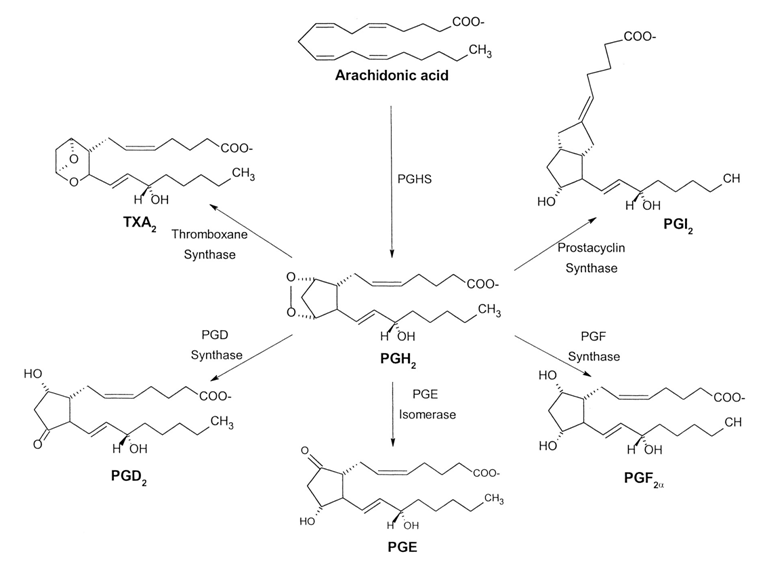Eicosanoids are a family of signaling molecules produced and secreted from many cells types under normal and pathophysiological conditions. In humans these metabolites are excreted to body fluids, such as plasma and urine. Precursors are 20-carbon PUFAs such as arachidonic acid (C20:4) esterified to phospholipids of cell membranes. Fatty acids (FAs) are mobilized from phospholipids by phospholipase A2 before they are available for further metabolism to eicosanoids. Therefore, FA membrane composition (i.e., the PUFA content) is cell type specific and therefore is crucial for cellular functions and influenced by nutrition.

Eicosanoid species have various and diverse physiological effects. However, the n-6 fatty acid arachidonic acid (C20:4) is a well-known eicosanoid precursor giving rise to mainly proinflammatory eicosanoids, including prostaglandins (PGs) (two series), thromboxanes (TXs) (two series), LTs (four series), and hydroxyeicosatetraenoic acid (HETE) derivates. Concentrations are elevated in various diseases and pathophysiological conditions, including type-1/type-2 diabetes, cardiovascular disease, obesity, multiple sclerosis, cystic fibrosis, bowel and pulmonary diseases, neurodegenerative diseases, and several forms of cancer.
Crucial urinary eicosanoid species produced from arachidonic acid related to oxidative stressorproinflammatory states are the following: A ) tetranor PGE-M, a stable metabolite of PGE 2 (present in plasma, relatively instable) synthesized by cyclooxygenase (COX)-1 and COX-2. Urinary levels are elevated in cancer patients (e.g., patients with lung cancer). B) 8-iso-PGF2α (also named 8-epi-PGF2α, 8-isoprostane, or iPF2α-III) is possibly the most prevalenteicosanoid molecule used as biomarker for oxidative stress because it has been validated. It is generated nonenzymatically by free radical-mediated oxidation of arachidonic acid. It is also present in plasma but is relatively unstable. Increased levels can be found in patients with neurodegenerative diseases or type-1/type-2 diabetes. C) 2,3-dinor-8-iso-PGF2α, a β-oxidation product of 8-iso-PGF2. D) 2,3-dinor-TXB2 and E) 11-dehydro-TXB2, stable urinary metabolites of TXA2 produced by COX-1. Levels are elevated in diabetes patients and assumed to reflect platelet activation. F) LTE4, a metabolite of LTD4 formed from LTC4; leukotriene synthesis is regulated by 5-lipoxygenase. LTE4 is used as biomarker to predict asthma and is believed to reflect the whole body LT status. G) 12-HETE generated by 12-lipoxygenase. Its concentrations are increased in female diabetes patients and hypertension patients. Similar to 11-dehydro-TXB2, it is assumed that increased 12-HETE levels are associated with platelet activation.
Urinary eicosanoids are commonly determined by GC-MS or LC-MS/MS, often requiring a complicatedand time-consuming sample extraction and derivatization. Although there are existing approaches for profiling of single urinary eicosanoid species, methods for quantification of urinary eicosanoid species generated from different pathways are rare.
Currently, a reliable and reproducible method using highly sensitive LC-MS/MS platform for the identification and quantification of diverse eicosanoid metabolites in different sample types has been established by the scientists at Creative Proteomics, which can satisfy the needs of academic and industrial study in your lab.
Platform
- LC-MS/MS
Summary
Profile of multiple kinds of eicosanoid metabolites (urine) by mixed organic solvent extractionin plasma or tissue. Eicosanoid metabolites are extracted and concentrated using solid phase extraction. The eluant is dried and re-suspended for LC-MS separation and measured using MRM methods.
Sample Requirement
- Normal Volume: 200 uL plasma, 20 mg tissue, 1e7 cells
- Minimal Volume: 50uL, 5 mg tissue, 6 e6 cells
Report
- A full report including all raw data, MS/MS instrument parameters and step-by-step calculations will be provided (Excel and PDF formats).
- Analytes are reported as uM or ug/mg (tissue), and CV's are generally<10%.
| Eicosanoid Metabolites (Urine) | ||
|---|---|---|
| PGE-M (tetranor-13,14-dihydro-15-keto-prostaglandin E2) | PGF-M (tetranor-13,14-dihydro-15-keto-prostaglandin F2α) | PGI-M (2,3-dinor-6-keto-PGF1α) |
| TXB-M (2,3-dinor-TXB2) | LTE4 | |
Ordering Procedure:

*If your organization requires signing of a confidentiality agreement, please contact us by email.
Staffed by experienced biological scientists, Creative Proteomics can provide a wide range of services ranging from the sample preparation to the lipid extraction, characterization, identification and quantification. We promise accurate and reliable analysis, in shorter duration of time! You are welcome to discuss your project with us.







